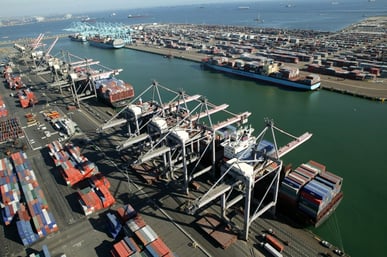OSLO – Norway, 31 October 2024
Ocean container carriers are desperately trying to push spot freight rates up in early November to halt the market decline and strengthen their hand during negotiations with European shippers for new long-term contracts.
Latest data from Xeneta – the leading ocean and air freight rate intelligence platform – shows average spot rates on the major fronthaul trades from the Far East to North Europe and the Mediterranean are set to increase on 1 November between 15-25%.
Average spot rates currently stand at 3 390 per FEU (40ft container) into North Europe and USD 3 430 per FEU into the Mediterranean, having both declined dramatically since the end of August by -55% and -49% respectively.
Peter Sand, Xeneta Chief Analyst, said: “European shippers could be spooked by the spot rate hike in early November, but they should not be.
“Carriers are desperate to keep the spot market elevated and halt the recent heavy declines. It is clear there is still volatility in ocean supply chains and carriers will point to the ongoing impact of conflict in the Red Sea, but the fundamental direction of the market is downward and the November rate increase is unlikely to stick for too long.”
Long term contract market falling
Many European shippers are currently locked in negotiations with ocean container carriers for new long-term contracts coming into force in January. An elevated spot market could strengthen a carrier’s negotiating position if it places upward pressure on the long-term market.
However, the Global Xeneta Shipping Index (XSI®), which measures all valid long-term rates in the market, fell in October for the first time in three months, down 5.6% to 157 points.
The XSI® sub-index for Far East Exports, which includes the major fronthauls to North Europe and Mediterranean, also fell by 7.5% in October to stand at 194.4 points.
Sand said: “Shippers should be buoyed by the latest data showing long-term rates are falling globally as well as at a trade level between the Far East and Europe.
“At the end of August, shippers on the Far East to North Europe trade were paying USD 4 420 more to move a container on the short-term spot market compared to the long-term market. That spread has narrowed to just USD 389 – most importantly for shippers, it is because the short-term market is falling rather than the long-term market rising.”
Tough negotiations
Sand believes negotiations between shippers and carriers for new long-term contracts could be challenging due to the market volatility during 2024 following escalation of conflict in the Red Sea.
He said: “Both shippers and carriers can put forward compelling arguments. Carriers will point out that average spot rates from the Far East to North Europe are still up 224% compared to 12 months ago and that the primary reason for this massive increase – the Red Sea conflict - will continue into 2025.
“Shippers will be closely monitoring the market data and point towards declining spot rates in recent months to push back strongly against increases in their new long-term rates.
“It is crunch time for shippers and carriers because neither side wants to be exposed to ongoing market volatility in 2025 by locking into long term rates that are either too high or too low. That is why the market is turning more towards index-linked agreements which work in the interests of both parties in the event of significant market movements.”
Ends




